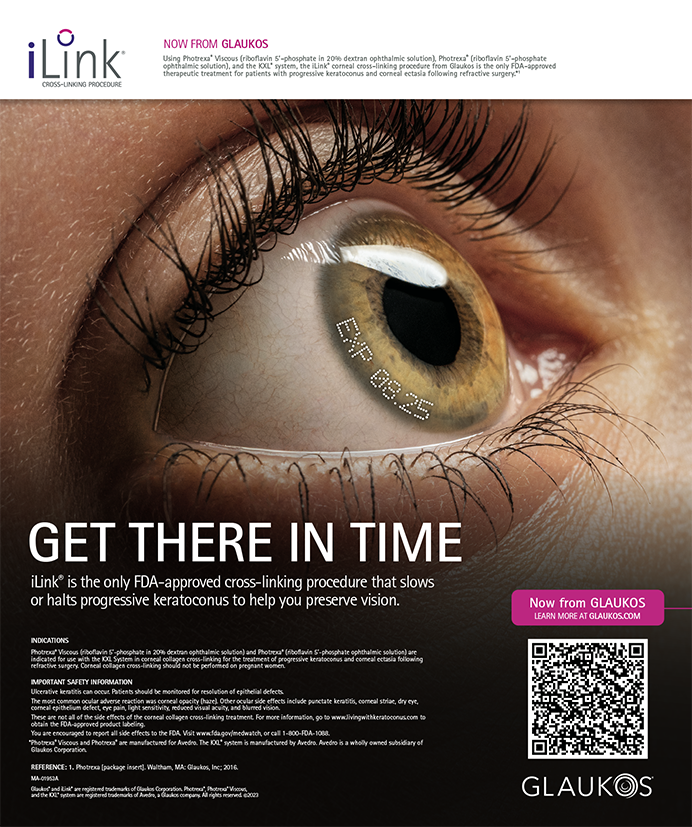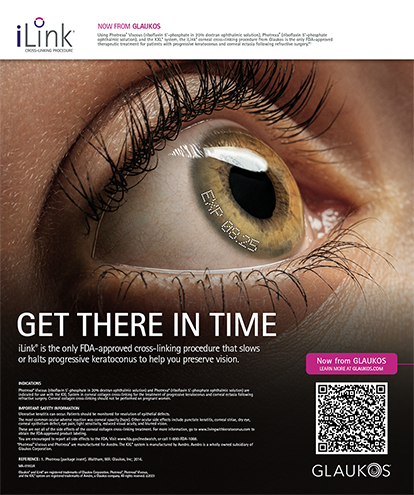For young people today, the idea of treating refractive errors with LASIK is a familiar and wellestablished one. Having grown up hearing about LASIK and possibly witnessing their parents' experience with the procedure, this generation has never known a time when LASIK was not available. LASIK has become the preferred refractive option among young people for three main reasons: the quality of vision it provides, the safety and comfort associated with the procedure, and its cost-effectiveness and convenience.
IMPROVED QUALITY OF VISION
It is our experience that LASIK consistently provides superior vision compared with contact lenses and spectacles, which we demonstrated in a recent study.1 We found that by the first postoperative day, LASIK performed with modern femtosecond lasers provided superior visual acuity and contrast sensitivity compared with the preoperative BCVA. This accounts for why patients report subjective improvement in both sharpness and quality of vision after LASIK. There are various reasons why LASIK demonstrates this advantage over traditional corrective lenses. Rather than simply compensating for astigmatism, LASIK has the ability to eliminate it. Most contact lenses are spherical and do not treat astigmatism, and toric contact lenses are difficult to wear and keep aligned. Furthermore, LASIK is the only modality that is specifically designed to address higher-order aberrations
SAFETY AND COMFORT
LASIK has continued to become safer, while previously unrecognized consequences of long-term contact lens use are beginning to become apparent. Modern-day femtosecond lasers have eliminated many of the rare flap complications related to microkeratomes.2 The incidence of post- LASIK ectasia is small, especially in the hands of experienced refractive surgeons, and it continues to decrease with better diagnostics, a greater awareness of risk factors, and a lower threshold for performing PRK when there is any question regarding risk.3 Should ectasia occur, however, corneal collagen cross-linking (not approved by the FDA) can halt the corneal deformation and deter loss of vision.4 Ulcerative keratitis continues to be a prevalent issue for contact lens wearers despite improved awareness, education, design, and lens solutions. Contact lens-related keratitis can lead to vision loss, necessitating corneal transplantation at worst and multiple days of discomfort and time off from work at best.
Based on the refractive evaluations we give to new patients at our practice, dry eye disease and endothelial cell loss are common trends among those who wear contact lenses. Despite higher oxygen permeability and disposable contact lenses, we are seeing an epidemic of dry eye disease even among young adults. In contrast, with modern thin flap LASIK and good lubrication of the ocular surface, it is rare to see more than transient dryness after surgery.2 We routinely measure endothelial cell counts in new patients and have observed endothelial cell loss and stress (polymegathism and polymorphism) in those who have worn contact lenses for an extended period. The effect of LASIK on endothelial cells has been rigorously studied and has never shown any evidence of adverse effects.5
COST-EFFECTIVENESS AND CONVENIENCE
LASIK offers superior cost-effectiveness to contact lenses. The additive costs of the lenses, doctors' visits, solutions, and backup spectacles pile up, exceeding the cost of LASIK after 10 years, depending on the particulars. Young adults must consider the cost of wearing contact lenses for at least 4 decades. By this calculation, LASIK provides considerable financial benefits over a lifetime. Adding to the financial incentive is the convenience of not having to worry about buying solution or ordering contact lenses and the daily time spent putting in, removing, and cleaning the lenses. Popular activities such as travelling, camping, and sports are easier without the worry of contact lenses. Additionally, with contact lenses, true spectacle independence is unobtainable, because glasses will still be needed from time to time, such as at the beginning and end of the day, when the eyes are irritated, or on long days. Beyond this, many patients appreciate the simple sense of security provided by LASIK, which allows people to see the clock next to their bed at night, to be free of worry about one's vision during an emergency or disaster, and to feel less self-conscious.
CONCLUSION
LASIK has become a rite of passage in our practice. In the past 7 years, the number of patients aged 25 years and younger presenting for new patient examinations has tripled. Many of our happy post-LASIK patients bring their adult children for evaluations. Due to the excellent visual outcomes, safety profile, cost and convenience, LASIK itself has undergone a rite of passage to become the preferred treatment for refractive error.
Daniel S. Durrie, MD, is the director of Durrie Vision in Overland Park, Kansas. Dr. Durrie may be reached at (913) 491-3330; ddurrie@durrievision.com.
Theodore A. Pasquali, MD, is the refractive fellow at Durrie Vision in Overland Park, Kansas. Dr. Pasquali may be reached at (913) 491-3330; tpasquali@durrievision.com.
- Durrie DS, Brinton JP, Avila MR, Stahl ED. Evaluating the speed of visual recovery following thin-flap LASIK with a femtosecond laser. J Refract Surg. 2012;28:620-624.
- Lee JK, Nkyekyer EW, Chuck RS. Microkeratome complications. Curr Opin Ophthalmol. 2009;20:260-263.
- Guedj M, Saad A, Audureau E, Gatinel D. Photorefractive keratectomy in patients with suspected keratoconus: five-year follow-up. J Cataract Refract Surg. 2013;39:66-73.
- Poli M, Cornut PL, Balmitgere T, et al. Prospective study of corneal collagen cross-linking efficacy and tolerance in the treatment of keratoconus and corneal ectasia: 3-year results [published online ahead of print October 18, 2012]. Cornea. doi:10.1097/ICO.0b013e31825e8414.
- Klingler KN, McLaren JW, Bourne WM, Patel SV. Corneal endothelial cell changes 5 years after laser in situ keratomileusis: femtosecond laser versus mechanical microkeratome. J Cataract Refract Surg. 2012;38: 2125-2130.


